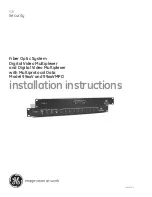
Vocality User Manual
User Manual for V200
Valid for V08_08.02 or V08_48.02
Page 9 of 114
2.2.1.2 CPU Card
The CPU card provides many functions critical to the V200 – configuration and control,
chassis and hot-swap management and storage of all application software. At least one
CPU card must be installed in each V200 – it is configured as Slot 0 and provides the
management facilities for the entire unit. Another CPU card may be present and
assigned as a redundant Slot 0 CPU card – this card monitors the operation of the active
Slot 0 CPU card and takes over operation of the Slot 0 functions if it detects that the
active Slot 0 card has failed.
By default it is assumed in this manual that your V200 is fitted with the High Speed CPU
card (HSCPU), which includes a multi-protocol serial data port capable of 10Mbps
operation, two 10/100/1000Mbps triple-speed Gigabit Ethernet ports, and an integrated
dynamic IP router with DHCP server, bridging and PEP. It also provides a serial
Management & Control (M&C) port, an Alarm port and an Alert push button for
invoking the hot-swap feature. Two LEDs indicate the status of the CPU card.
Other Standard CPU cards may be present as line cards using the single data port, two
10/100/1000base-T Ethernet ports and integrated IPv4 router.
2.2.1.2.1
Control and Monitoring
The CPU card has a dedicated 6-way locking mini-DIN connector labelled “M&C”. This
port has an RS232 interface and presents either a formatted display for network control
or a terse teletype mode for integration into the overall network management system.
The facility for uploading and downloading configuration data using script files is also
provided.
The mandatory CPU card in Bay A of a V200 chassis is the master controlling entity.
Even when this card has a secondary for backup purposes in Bay B, the leftmost card is
the primary card unless it becomes faulty. The unit must therefore be managed through
this card, either using the serial M&C port or via remote Telnet access.
All of the cards in a chassis and all of the units in a network may be controlled from the
management port of the primary CPU card in a chassis, remote or hub. This includes
any chassis connected via a High Speed Channel link at any point in the network.
Remote management bandwidth is taken from the asynchronous data dynamic pool. A
minimum of 2400bps is used in times of congestion and a maximum bandwidth, up to
the aggregate rate, is used when there is no other traffic. In this way, the responsiveness
of a connection to a remote unit is optimised at all times.
2.2.1.2.2
Compact FLASH
All of the configurations, application software and the firmware, for each card installed
in the V200 chassis, are stored on the compact FLASH located on the CPU card. This
makes it easier to upgrade the software and the firmware on cards and guarantees
cards of the same type are running identical software. This also ensures that disaster
recovery can be achieved by simply removing the compact FLASH card and replacing it
with a new pre-programmed one.
New software can be downloaded to the compact FLASH via TFTP. See
Section 5.2
Upgrading your software - via menus
for more information.
Содержание V200
Страница 1: ...i User Manual for V200 Valid for V08_08 02 or V08_48 02 January 2014 ...
Страница 10: ......
















































